Tap tempo delay pedals come with a built-in tap tempo function. This is usually a switch or button on the front of the pedal that allows you to control the delay time by tapping your foot. Instead of making changes by hand and on the fly, tap tempo delay pedals are far more convenient and intuitive to use.
The ability to specify the delay time by tapping your foot on the switch has made this type of delay pedal immensely popular. There are seemingly endless models of tap tempo delay pedals on the market. They run the gamut from simpler units to elaborate delay machines that offer you tons of variety and control options.
Other models also combine tap tempo delay with other effects, including reverb and even looping. Usually, these tend to have dedicated controls for operating each effect individually.
With so many options out there, how do you know where to start looking? We’re here to help! Keep reading.
Read more about our review process.
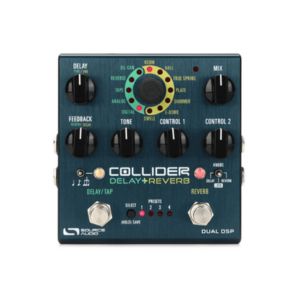
Source Audio Collider Stereo Delay+Reverb
Features: Buffered and true bypass options, Stereo I/O, Dual 56-bit DSP processors
Benefits: Studio grade tones, Easy tap tempo access, Extremely well made
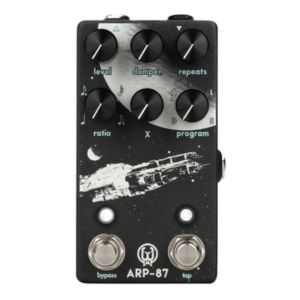
Walrus Audio ARP-87 Multi-Function Delay Pedal
Features: Dynamic X knob, Die cast metal housing, Trails/No-trails modes
Benefits: Versatile delay/reverb settings, Broad tonal range, Excellent clarity
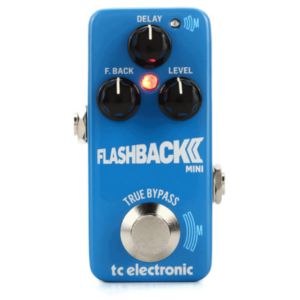
TC Electronic Flashback 2
Features: TonePrint Technology, Switchable true/buffered bypass, MASH footswitch
Benefits: Tiny footprint, Hundreds of presets available, Acts like an expression pedal
Contents
Our Top 3
The Walrus Audio ARP-87 Multi-Function Delay Pedal is our Top Pick. This is a multi-function delay unit that offers a wide tonal range with great flexibility to control it in a number of ways.
The TC Electronic Flashback 2 Mini Delay Pedal is our Best Budget pick. This is a compact and reimagined version of the Flashback 2 delay pedal, and offers eight delay types for great versatility in a small and convenient unit.
The Source Audio Collider Stereo Delay+Reverb Pedal is our Editor’s Choice. This is an excellent choice for dedicated professionals who need a complete delay machine with superior quality and control options on an intuitive design.
Individual Reviews
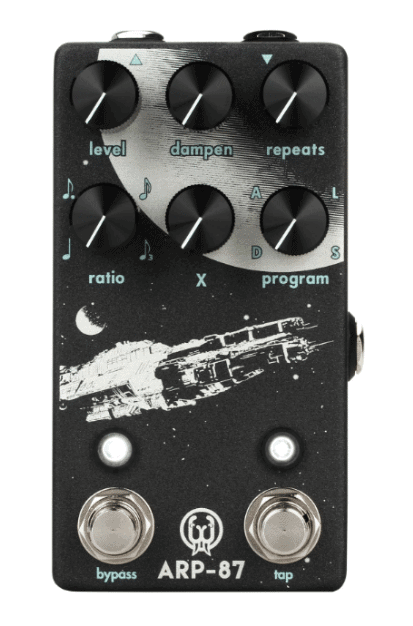
Walrus Audio ARP-87 Multi-Function Delay Pedal
A great blend of quality and extensive features.
Walrus Audio is renowned for creating quality tools that let musicians get truly creative. The ARP-87 is no exception and offers the user great flexibility in a cleverly designed delay stompbox.
The Walrus Audio ARP-87 is a multi-function guitar delay pedal that covers a wide tonal range. With Digital, Analog, Lo-Fi, and Slap settings, this pedal offers fantastic flexibility to operate your delays whoever you see fit.
One of the most singular aspects of this pedal is the “X” knob. The function of this knob changes depending on which setting you use. For instance, when the pedal is set to Digital, Analog, and Slap modes, the X knob controls modulation depth. When set to Lo-Fi mode, it then controls the filter width.
With fantastic build quality, the ARP-87 features six knobs: Level, Dampen, Repeats, Ratio, X, and Program, where you select one of the four operating modes. With the exception of X, all these knobs are self-explanatory. This pedal also comes with two switches, one for bypass and the other for tap tempo.
To begin our tests, we set the ARP-87 to Digital mode. We got a balanced digital delay, which was never too bright. We particularly liked it with the ratio set at noon, while keeping the Dampen and Repeat knobs at low levels.
Next, we tried the Analog voice. Here, our repeats were softened in an ear-pleasing way, especially with brighter tones which will cut through a dense mix. This voice was at its best when we added a bit of modulation via the X knob.
The Lo-Fi mode/voice had a nice character and added tons of vibe and personality to our tone. We especially liked how it worked with heavier delays with extended repeats, and at higher rates. With the X control, we were able to adjust a filter that made the frequency range a bit more narrow. This setting was also great for experimenting, especially when we paired it with our Tube Screamer.
In short, a very complete delay pedal that covers the basics of delay and takes you well beyond. With fantastic build quality and great features, this Walrus delay is one of the best in the market today.
Verdict: The Walrus Audio ARP-87 gives you great versatility in a well-built unit. With a multi-function approach, this pedal comes with Digital, Analog, Lo-Fi, and Slap settings for great flexibility.
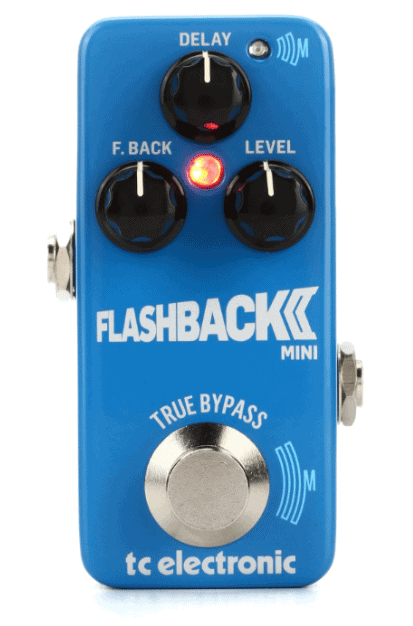
TC Electronic Flashback 2 Mini Delay Pedal
Straightforward delay on a compact unit.
This TC Electronic mini pedal is a great option for folks that have tight pedalboards but need to have a quality delay effect. Durable and convenient, you get a simple yet effective delay unit that does more than what its price suggests.
The TC Electronic Flashback 2 Mini Delay Pedal is a compact and reimagined version of this company’s popular Flashback 2 delay pedal. And just like the original, the mini version gives you eight delay types. All of these are accessible via the USB port on the back of the unit or wirelessly through TC Electronic’s TonePrint technology.
Although this pedal has quite a small footprint, it offers dozens of algorithms for you to alter. You can even create your own! This is all done via the TonePrint app, available for iOS or Android, for your smartphone or tablet.
We started our tests by trying out the tape delay that you have as soon as you power up this pedal. This was a rather traditional delay effect and we liked it the best at low settings. We had it with all three knobs at about just below 10 am. This added some ambiance to our clean open chords and can be used in a variety of contexts.
We then wanted to go to the other extreme and tried out the Crystal octave shimmer effect. Here we got some ethereal synth-like pad tones that took our Strat straight into avant-garde and experimental land. This was great for laying down chords and for some out-there soloing as well.
In short, a well-designed pedal that offers a lot of options for such a small size. With a MASH footswitch that helps enhance expression and the TonePrint feature, this pedal is great for tight budgets and tight spaces.
Verdict: The TC Electronic Flashback 2 is a smaller version of the Flashback 2 delay pedal and features eight delay types. Ultra compact, well-built, and with switchable true/buffered bypass, this pedal is a great option for folks with tight pedalboards.
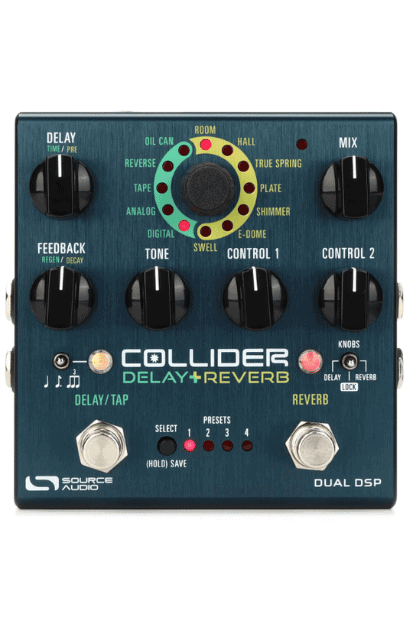
Source Audio Collider Stereo Delay+Reverb Pedal
A complete delay machine for superior control.
The engineers at Source Audio managed to create a comprehensive solution for both delay and reverb with the Collider. Besides offering you quality effects, you also get deep editing and virtually no limitations as to how this pedal operates.
The Source Audio Collider Stereo Delay+Reverb Pedal features five delay engines (and seven reverb types) in one powerful unit that delivers complete control in an intuitive design. Because it comes with dual 56-bit DSP processors you can run both effects simultaneously.
The folks at Source Audio designed the delay section of the Collider based on classic and modern delay types. This way you get Tape, Analog, and Oil can delay modes for the classic side. On the other hand, you get Reverse and Digital modes for your modern delays.
In our tests, we discovered that this unit is truly user-friendly, despite offering comprehensive solutions to your delay and reverb needs. We started by playing our Strat through the first Delay mode option which is Digital. Here we got pristine delay, which we took from subtle to wacky with the turn of the Delay and Feedback knobs.
We then moved on to the Analog mode, where we got a nice Bucket Brigade Device type of sound and vibe. For more traditional and warmer delays, Tape mode proved to be ideal, particularly with the Delay and Feedback knobs dialed at low settings. Tape was one of our favorite modes on the delay side of this pedal, as it gave us warmth and a quality that can be used in numerous situations.
Reverse mode was also useful to jet us to a bit of psychedelia, especially when the Tone knob is set beyond noon. We also really liked the Oil Can delay mode. Here we got a type of lo-fi emulation that invited us to get experimental and lost in a dense texture that can work nicely for out-of-the-box uses.
With plenty of more features like dedicated footswitches to individually control delay and reverb separately, this pedal is an ideal choice for discerning musicians who value quality, features, and ease of use.
Verdict: The Source Audio Collider Stereo Delay+Reverb pedal gives you five delay modes and seven reverb types in a powerful and well-built unit. With dual 56-bit DSP processors, this pedal is easy to use and gives you vast editing possibilities on quality effects.
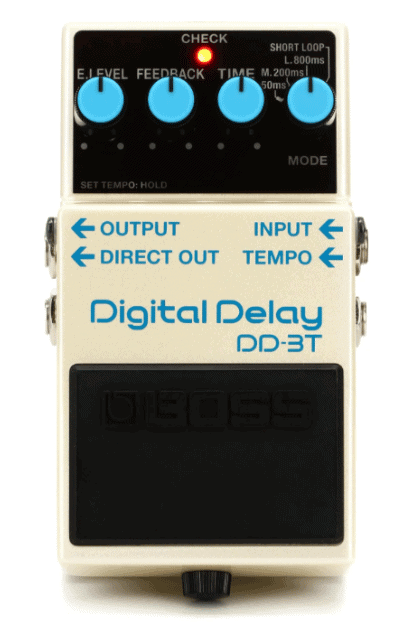
Boss DD-3T Digital Delay
A true classic that is still relevant today.
The Boss Digital Delay pedal has been around for over 30 years and remains a common choice in the pedalboards of guitarists all around the world. That kind of longevity and popularity speaks volumes of the quality of this simple yet useful delay pedal, now on version 3T.
The Boss DD-3T Digital Delay 3 builds on the legacy of the Boss Digital Delay, which has been a staple of basic effects for guitarists for a really long time. Besides the renowned Boss stompbox form factor and the durability it features, this pedal also gives you 12.5ms to 800ms of clean digital repeats.
The DD-3T also features an onboard tap tempo and tap switch input with three subdivisions, so you can time your delays just the way you want them. Another improvement on this version includes Short Loop, previously known as the Hold function. Here you get continuous loops all the way to 800ms of sound so you can play on top.
For this version, Boss also decided to relocate the Direct Out in order to offer improved workflow by making integration with the rest of your stomps a bit easier.
We were eager to try this pedal out, as we had the opportunity to work with the original DD-3 a few years back. Right off the bat, we wanted to try the main addition to this version, which is the built TAP tempo function.
We tried this pedal while playing along with some songs playing from our DAW. We tapped the tempo of the song in question in order to accurately sync the delay time to the song. This was quite easy and worked like a charm, making the DD-3T that much more useful.
As far as the tone itself, this version maintains the warmth of the DD-3. It is important to remember that the circuit on this pedal is mostly analog. Although it does feature a delay chip that is digital (12 bit), the clean tone is very natural, which is partly why this pedal has been so popular. In our tests, we got that same organic tone with the DD-3T, and we’re certainly glad that Boss opted to keep the tone intact on this new version.
In short, an enhanced version of a classic pedal, great for musicians looking for basic delays. Those that need deep editing capabilities may want to look elsewhere.
Verdict: The Boss DD-3T Digital Delay 3 is a new version of the revered DD-3. With a new tap tempo function, relocated direct out, and renamed Hold function, this pedal is now more powerful but keeps all the desirable traits from the original.
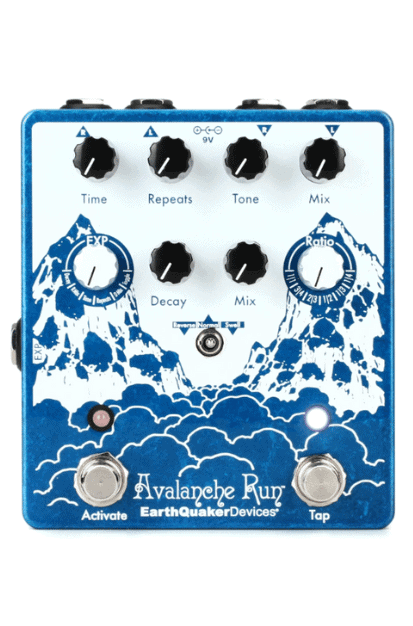
EarthQuaker Devices Avalanche Run V2 Delay and Reverb
Superior versatility and control options.
This company is known for offering superior quality and a very unique flavor with all of its pedals. The Avalanche Run is further proof of that and has a strong identity that you are unlikely to find with another pedal.
The EarthQuaker Devices Avalanche Run V2 Delay and Reverb Pedal feature an ingenious design that gives you everything from a tape-style delay with bucket brigade sensibilities all the way to wacky textures for experimental folks. It also doubles as a complete reverb unit.
The top four black knobs are labeled Time, Repeats, Tone, and Mix, and they give you plenty of options to control your delays. The bottom two black knobs are Decay and Mix, for dialing in your reverbs.
The are also two rotary switches, one for assigning the parameter to the expression pedal (not included), and the other for selecting delay subdivisions (quarter-note, dotted-eighth, quarter-note triplet, eighth-note, eighth-note triplet, and 16th-note).
There’s also a toggle that unlocks much of the magic of the Avalanche Run. Here you get to select between reverse delay, standard digital delay, and a swell delay that functions like an auto-volume pedal.
For our tests, we were eager to unlock the uniqueness that the Avalanche Run offers. EarthQuaker Devices units are known for having a distinctive personality and this pedal is no exception. Naturally, this unit also does a good job as a straightforward delay and reverb unit.
After trying the delay out in a few modest settings, we set this pedal on Swell mode and held down the tap tempo footswitch. This took the delay effect into self-oscillation and gave us a wacky dub effect. We loved how it paired with our Tube Screamer.
We then switched it to Reverse mode and discovered when the tap tempo switch is held, the delay effect goes back to normal. The sound quality of this pedal is clean, devoid of any noise, and perfect for fat and rich tones.
In short, a fantastic pedal for folks who like to go deep and favor uniqueness. More traditional players may want to get a simpler unit.
Verdict: The EarthQuaker Devices Avalanche Run V2 Delay and Reverb Pedal is a great unit that can handle basic delay and reverb effects, and also offers plenty of unique functions. Well-built and with great sound quality, this pedal is ideal for those who want something off the beaten path.
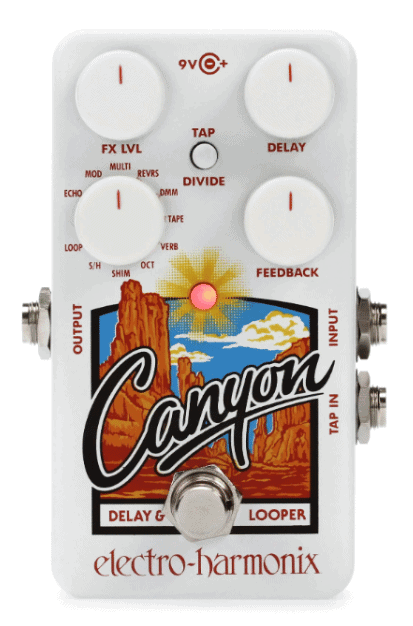
Electro-Harmonix Canyon Delay and Looper Pedal
A clever design for your delay needs.
Electro Harmonix has a solid reputation for creating fantastic pedals that excel in tone, functionality and durability. The Canyon certainly fits all of the above, and also adds convenience, as it is a relatively small stompbox that packs a punch.
The Electro-Harmonix Canyon is a simple yet effective delay unit that also doubles as a looper pedal. Featuring eight delay types, including Tape, Deluxe Memory Man, and Reverse, this pedal can pivot from traditional to experimental as needed. This is impressive for a pedal that looks like your regular one-effect stompbox.
Another ingenious feature of the Caynoy is its dual-function footswitch. Here you can tap the tempo you want your delay at and add rhythmic subdivisions. Also, pressing it down changes the function of the control knobs, which gives you access to deep editing parameters, including repeated signal’s modulation, tape age, and more.
In our tests, one of our favorite delay types was the Octave. Using our Strat, we got lush arpeggiated sequences of high and low octaves from the original notes we played. By altering the delay time clockwise, we created some intense soundscapes for more ethereal contexts.
Another one of our favorites was the Tape delay mode, where we got a warm tone and very natural delay. Having the Delay and Feedback knobs dialed at low settings added beautiful depth to our tone and worked nicely for open chords and gave our single lines a bit more liveliness.
In short, an ingenuous and well-built delay pedal that also doubles as a looper. As good as this pedal is, it doesn’t offer stereo operation, which may be a deal-breaker for some folks.
Verdict: The Electro-Harmonix Canyon is a delay unit that can handle all your basic delay needs and also take you to the wild side. Featuring a fantastic looper, it comes with eight delay types, so you have plenty of options and then some on a very well-built unit.
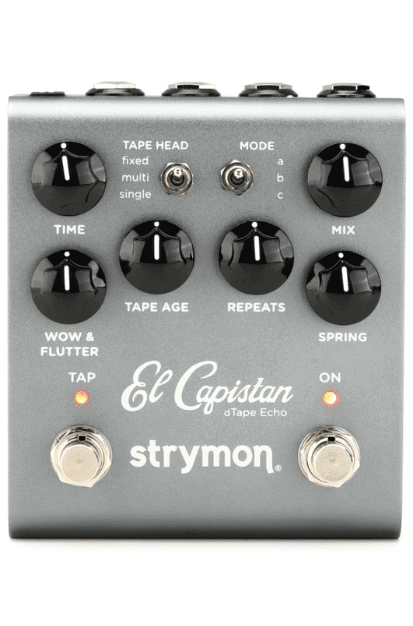
Strymon El Capistan dTape Echo Pedal V2
Classic delay with plenty of control options.
Strymon is renowned for offering quality tools that let the user go deep. From fantastic sound to several operation modes for wider control, this delay unit is one of the best on the market today.
The Strymon El Capistan dTape Echo Pedal V2 offers you a comprehensive tape echo emulation pedal with a vast variety of classic delay effects. You can select from three tape machine styles which include Fixed, Multi, and Single. Each offers three operation modes, so you have deeper control over your tone.
One of the features that makes this pedal excel is the rear-panel switch that lets you go from mono to stereo operation and back.
We ran our tests with our faithful Fender Strat and were impressed by how responsive and dynamic this pedal was. This is thanks to the JFET input circuit as well as the ARM DSP chip which improves processing power.
During our tests, we got a kick out of the Tape Age knob. By turning it clockwise, we altered the tone of the delay, making it sound more like the classic delays of yore. We also loved the Wow & Flutter knob, which let us delve into the peculiarities of old tape delay machines. Producing a warm modulated tone, we got a great recreation of tape delay and its particular feel.
We also found that the tap tempo function made it easy to program just the tempo that we wanted, and added a bit of space to our tone as well. Like all of Strymon’s stompboxes, this one is also built like a tank, ready to take on the abuse of the road. In short, a great pedal for classic delay. Folks that prefer something more simple and gravitate towards digital delay may want to consider other options.
Verdict: The Strymon El Capistan dTape Echo Pedal V2 is a powerful tape echo emulation unit that offers tons of possibilities for classic delay. With three tape machine styles to choose from, tap tempo and spring reverb control, this pedal is a fantastic choice for detailed musicians that favor classic delay.
How to Choose the Right Pedal for You
Tap tempo delay pedals allow you to quickly change the tempo of the delay, making it very convenient during live performances. In other words, you can set the delay tempo for the current song without having to spend a bunch of time between songs bending to tinker with knobs.
Digital vs Analog
This debate also lives on regarding delays. Although there are many differences between digital and analog delay pedals, the most important aspect is the sounds you prefer and what you need the pedal for.
Analog delay pedals tend to offer warmth, while digital pedals are known for offering pristine clarity to your sound.
Analog delay pedals rely on a bucket brigade device (BBD), where the analog signal goes through a series of capacitors. With each cycle, the signal is broken up more and in the process, you get a warm sound characteristic with analog gear.
On the other hand, digital delay pedals transform the signal twice. Once from analog to digital, and then vice versa. Some folks feel digital delays change your guitar tone during said conversion. However, digital delay pedals offer longer delay times as well as more parameters and settings to adjust the tone.
So What Do I Get?
Like most things guitar-related, the most direct and honest answer is “it depends.” On what, you might ask. Well, on your needs and what you’re looking for.
For instance, many tap tempo delay pedals come with additional features that are superfluous or redundant. Take reverb and looping, for example. You may very well already have existing reverb pedals or loopers. If that’s the case, you don’t need to pay extra for those features in a delay pedal.
I know it can be frustrating at times, but asking yourself what you need the pedal for is central to the unit you’ll end up buying. Are you a detailed player who likes to have endless options and deep editing capabilities? Or do you prefer a delay pedal that’s rather simple and with a great tone? Only you can answer those questions.
Final Thoughts
Tap tempo delay pedals are very convenient and useful, as they allow you to dictate your delay’s tempo with your foot during live performance. There are plenty of models and they come with varied features. Trying some for yourself is vital to getting a better understanding of how they work and what you like best.
To recap our choices, the Walrus Audio ARP-87 Multi-Function Delay Pedal is our Top Pick. This is a multi-function delay unit with a vast tonal range and excellent flexibility in sounds and control options.
The TC Electronic Flashback 2 Mini Delay Pedal is our Best Budget. A much smaller and reimagined version of the Flashback 2 delay pedal, it comes with eight delay types for amazing versatility on a little and convenient unit.
The Source Audio Collider Stereo Delay+Reverb Pedal is our Editor’s Choice. This is a perfect choice for devoted professionals that require a complete delay unit with outstanding quality and control options.


